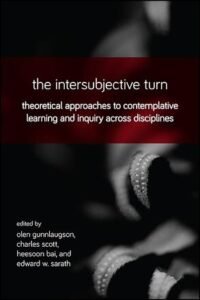A Radical Approach to Second-Person Contemplative Education – Jorge Ferrer & Olga Sohmer
Most spiritually informed approaches to education consist of the introduction of traditional contemplative practices—such as meditation, yoga, or Tai Chi—as independent courses in the curriculum or as components of class sessions. Typically, there is a period of mindfulness meditation before class begins, ritual closure, or contemplative “labs” (see, e.g., Hill, 2006; Miller, 1994; Simmer-Brown & Grace, 2011). These strategies are often understood as a preparation for—or enriching complement to—intellectual learning. For example, although Naropa University aims at the cultivation of a holistic human development, its official statement on contemplative education indicated, “the practice of sitting meditation and other contemplative practices…prepares the mind to process information in new and unexpected ways” (as cited in Gunnlaugson, 2009a, p. 19). Furthermore, as Gunnlaugson (2009a, 2009b) showed, most contemplative educators use first-person (i.e., individual subjective) or third-person (i.e., presumably objective) approaches with insufficient attention given to second-person or intersubjective approaches.
According to Gunnlaugson (2009b), these overlooked “second-person approaches to contemplative education involve exploring contemplative experience from an intersubjective position that is represented spatially as between us, in contrast to inside us…or outside us” (p. 27). Given this context, the main purpose of this chapter is to introduce Embodied Spiritual Inquiry (ESI) as a novel, second-person approach to participatory learning and contemplative education. While second-person contemplative approaches tend to be verbal or dialogical (e.g., Sarath, 2006), or to use presence or awareness exercises (e.g., Barbezat & Bush, 2013; Gunnlaugson, 2009b, 2011), ESI systematically—and, we argue, radically—engages contemplative intersubjectivity through mindful physical contact among practitioners. This contact occurs at not only the verbal and awareness levels but also the somatic and energetic levels. Contemplation is thus not applied as a preparation for or enhancement of intellectual learning (valuable strategies in themselves), but as the very means of a multidimensional, participatory inquiry seeking to intersubjectively access the epistemic power of all human attributes (i.e., body, vital world, heart, mind, and consciousness; Ferrer, 2002; Ferrer, Romero, & Albareda, 2005). Exploring the methodology and pedagogy of ESI as a research approach in a graduate course, this chapter aims to expand the repertoire of approaches to catalyzing intersubjective knowledge in the context of second-person contemplative education.
